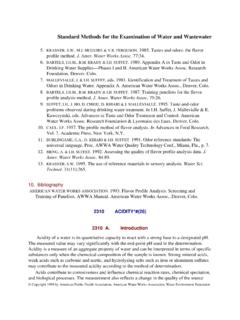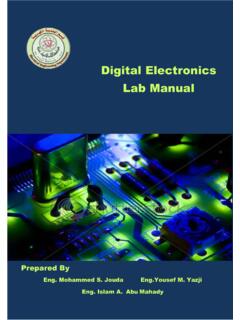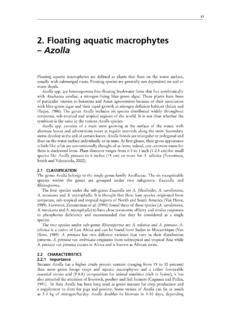Transcription of Okafor N. Modern industrial microbiology and biotechnology ...
1 Modern IndustrialMicrobiology and BiotechnologyModern IndustrialMicrobiology and BiotechnologyModern IndustrialMicrobiology and BiotechnologyNduka OkaforDepartment of Biological SciencesClemson University, ClemsonSouth CarolinaUSAS cience PublishersEnfield (NH)JerseyPlymouthSCIENCE PUBLISHERSAn imprint of Edenbridge Ltd., British Office Box 699 Enfield, New Hampshire 03748 United States of AmericaWebsite: @ (marketing department)editor@ (editorial department)info @ (for all other enquiries)Library of Congress Cataloging-in-Publication DataOkafor, industrial microbiology and bitechnology/Nduka bibliographical references and 978-1-57808-434-0(HC)ISBN 978-1-57808-513-2(PB)1. industrial microbiology . 2. biotechnology . I. 2--dc222006051256 ISBN978-1-57808-434-0 (HC)ISBN978-1-57808-513-2 (PB) 2007, Nduka OkaforAll rights reserved.
2 No part of this publication may be reproduced, stored ina retrieval system, or transmitted in any form or by any means, electronic,mechanical, photocopying, recording or otherwise, without the book is sold subject to the condition that it shall not, by way of trade orotherwise, be lent, re-sold, hired out, or otherwise circulated without thepublisher s prior consent in any form of binding or cover other than that inwhich it is published and without a similar condition including thiscondition being imposed on the subsequent by Science Publishers, Enfield, NH, USAAn imprint of Edenbridge in book is dedicated to the Okafor -Ozowalu family of Nri,Anambra State, Nigeria, and their IndustrialMicrobiology and BiotechnologyThe field of industrial microbiology has been undergoing rapid change in recent , what has been described as the cook book approach has been largely abandonedfor the rational manipulation of microorganisms on account of our increased knowledgeof their physiology.
3 Second, powerful new tools and technologies especially geneticengineering, genomics, proteomics, bioinformatics and such like new areas promiseexciting horizons for man s continued exploitation of microorganisms. Third, newapproaches have become available for the utilization of some traditional microbialproducts such as immobilized enzymes and cells, site-directed mutation and metabolicengineering. Simultaneously, microbiology has addressed itself to some currentproblems such as the fight against cancer by the production of anti-tumor antibiotics; ithas changed the traditional practice in a number of areas: for example the deep sea hasnow joined the soil as the medium for the search for new bioactive chemicals such asantibiotics.
4 Even the search for organisms producing new products has now beenbroadened to include unculturable organisms which are isolated mainly on genesisolated from the environment. Finally, greater consciousness of the effect of fossil fuelson the environment has increased the call in some quarters for the use of moreenvironmentally friendly and renewable sources of energy, has led to a search foralternate fermentation substrates, exemplified in cellulose, and a return to fermentationproduction of ethanol and other bulk chemicals. Due to our increased knowledge andchanged approach, even our definitions of familiar words, such as antibiotic and speciesseem to be changing. This book was written to reflect these changes within the context ofcurrent book is directed towards undergraduates and beginning graduate students inmicrobiology, food science and chemical engineering.
5 Those studying pharmacy,biochemistry and general biology will find it of interest. The section on waste disposalwill be of interest to civil engineering and public health students and practitioners. Forthe benefit of those students who may be unfamiliar with the basic biologicalassumptions underlying industrial microbiology , such as students of chemical and civilengineering, elements of biology and microbiology are introduced. The new elementswhich have necessitated the shift in paradigm in industrial microbiology such asbioinformatics, genomics, proteomics, site-directed mutation, metabolic engineering, thehuman genome project and others are also introduced and their relevance to industrialPrefaceviiiModern industrial microbiology and Biotechnologymicrobiology and biotechnology indicated.
6 As many references as space will permit various applications of industrial microbiology are covered broadly, and thechapters are grouped to reflect these applications. The emphasis throughout, however, ison the physiological and genomic principles behind these would like to express my gratitude to Professors Tom Hughes and Hap Wheeler(Chairman) of the Department of Biological Sciences at Clemson University for their helpand encouragement during the writing of the book. Prof Ben Okeke of Auburn University,Alabama, and Prof Jeremy Tzeng of Clemson University read portions of the script and Iam deeply grateful to wife, Chinyelu was a source of constant and great support, without which theproject might never have been completed. I cannot thank her , South CarolinaNduka OkaforContentsixPrefaceviiSECTION AINTRODUCTION1.
7 Introduction: Scope of biotechnology andIndustrial Nature of biotechnology and industrial Characteristics of industrial industrial vs medical microbiology Multi-disciplinary or Team-work nature ofindustrial Obsolescence in industrial microbiology Free communication of procedures in industrial microbiology Patents and Intellectual Property Rights inIndustrial microbiology and The Use of the Word Fermentation in industrial Organizational Set-up in an industrial microbiology Establishment10 Suggested Readings13 SECTION BBIOLOGICAL BASIS OF PRODUCTIVITY ININDUSTRIAL microbiology AND BIOTECHNOLOGY2. Some Microorganisms Commonly Used inIndustrial microbiology and Basic Nature of Cells of Living Classification of Living Things: Three Domains of Living Taxonomic Grouping of Micro-organisms Important inIndustrial microbiology and Bacteria Eucarya: Fungi Characteristics Important in Microbes Used inIndustrial microbiology and Biotechnolgy31 Suggested Readings33 ContentsxModern industrial microbiology and Biotechnology3.
8 Aspects of Molecular Biology and Bioinformatics ofRelevance in industrial microbiology and Biotechnology3 Protein The Polymerase Chain Some applications of PCR in industrial microbiology Applications of microarray Sequencing of Sequencing of short DNA Sequencing of genomes or large DNA The Open Reading Frame and the Identification of Nature of Some contributions of bioinformatics to biotechnology51 Suggested Readings524. industrial Media and the Nutrition of industrial Organisms5 The Basic Nutrient Requirements of industrial Criteria for the Choice of Raw Materials Used in industrial Some Raw Materials Used in Compounding industrial Growth Some Potential Sources of Components of industrial Carbohydrate Protein sources The Use of Plant Waste Materials in industrial microbiology Media:Saccharification of Cellulose, hemi-celluloses and lignin in plant materials73 Suggested Readings765.
9 Metabolic Pathways for the Biosynthesis ofIndustrial microbiology Products7 The Nature of Metabolic industrial Microbiological Products as Primary and Secondary Products of primary metabolism Products of secondary Trophophase-idiophase Relationships in the Production ofSecondary Role of Secondary Metabolites in the Physiology ofOrganisms Producing Pathways for the Synthesis of Primary and Secondary Metabolites ofIndustrial Catabolism of The Catabolism of Carbon Pathways for the Formation of SomeIndustrial Products Derived from Primary Catabolic products Anabolic Carbon Pathways for the Formation of Some Products ofMicrobial Secondary Metabolism of industrial Importance89 Suggested Readings986. Overproduction of Metabolites of industrial Microorganisms Mechanisms Enabling Microorganisms to Avoid Overproduction ofPrimary Metabolic Products Through Enzyme Substrate induction Catabolite regulation Feedback regulation Amino acid regulation of RNA synthesis Energy charge Permeability control Derangement or Bypassing of Regulatory Mechanisms forthe Over-production of Primary Metabolic control Permeability Regulation of Overproduction in Secondary Catabolite regulation Feedback regulation ATP or energy charge regulation of secondary metabolites Empirical Methods Employed to Disorganize RegulatoryMechanisms in Secondary Metabolite
10 Production120 Suggested Readings1207. Screening for Productive Strains and StrainImprovement in Biotechnological Sources of Microorganisms Used in Literature search and culture collection Isolation de novo of organisms producingmetabolites of economic importance Strain Selection from naturally occurring variants Manipulation of the genome ofindustrial organisms in strain improvement126 Suggested Readings1708. The Preservation of the Gene Pool inIndustrial Organisms: Culture The Place of Culture Collections inIndustrial microbiology and Types of Culture Collections172xiiModern industrial microbiology and Handling Culture Methods of Preserving Microbial preservation methods based on thereduction of the temperature of Microbial preservation methods based on Microbial preservation methods based on thereduction of The need for experimentation to determine themost appropriate method of preserving an organism178 Suggested Redings178 SECTION CBASIC OPERATIONS IN industrial FERMENTATIONS9.
















